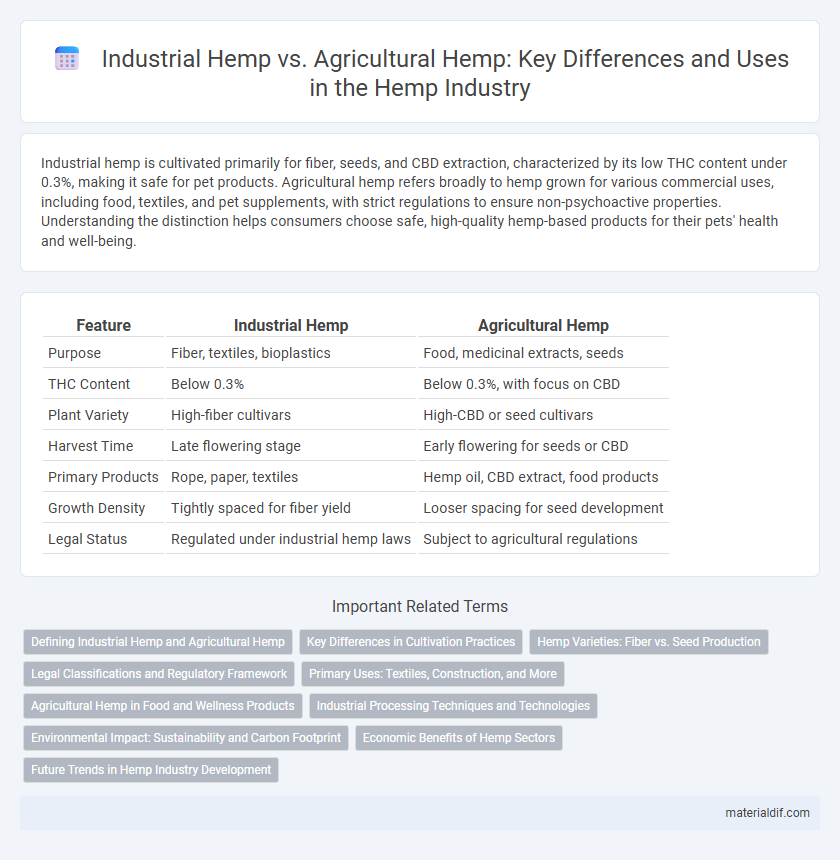Industrial hemp is cultivated primarily for fiber, seeds, and CBD extraction, characterized by its low THC content under 0.3%, making it safe for pet products. Agricultural hemp refers broadly to hemp grown for various commercial uses, including food, textiles, and pet supplements, with strict regulations to ensure non-psychoactive properties. Understanding the distinction helps consumers choose safe, high-quality hemp-based products for their pets' health and well-being.
Table of Comparison
| Feature | Industrial Hemp | Agricultural Hemp |
|---|---|---|
| Purpose | Fiber, textiles, bioplastics | Food, medicinal extracts, seeds |
| THC Content | Below 0.3% | Below 0.3%, with focus on CBD |
| Plant Variety | High-fiber cultivars | High-CBD or seed cultivars |
| Harvest Time | Late flowering stage | Early flowering for seeds or CBD |
| Primary Products | Rope, paper, textiles | Hemp oil, CBD extract, food products |
| Growth Density | Tightly spaced for fiber yield | Looser spacing for seed development |
| Legal Status | Regulated under industrial hemp laws | Subject to agricultural regulations |
Defining Industrial Hemp and Agricultural Hemp
Industrial hemp refers to varieties of the Cannabis sativa plant specifically cultivated for fiber, seeds, and CBD extraction, typically containing less than 0.3% THC to comply with legal standards. Agricultural hemp encompasses broader cultivation practices, including industrial hemp but also varieties grown for food products, animal bedding, and biofuel purposes. Both types focus on low-THC cannabis strains, yet industrial hemp is primarily targeted for commercial manufacturing and processing.
Key Differences in Cultivation Practices
Industrial hemp is cultivated primarily for fiber, seeds, and CBD production, requiring dense planting and minimal pesticide use to optimize stalk quality and yield. Agricultural hemp used for grain and livestock feed is grown with wider spacing to encourage larger seed heads and often receives more fertilizer to boost seed production. The cultivation practices differ significantly in row spacing, nutrient management, and harvest timing to meet the distinct end-use requirements of industrial versus agricultural hemp.
Hemp Varieties: Fiber vs. Seed Production
Industrial hemp varieties are specifically bred for high fiber yield, featuring tall stalks with strong, fibrous bast used in textiles and construction materials. Agricultural hemp varieties prioritize seed production, offering dense flowering tops rich in oils and nutrients for food, cosmetics, and supplements. Fiber-focused hemp typically contains lower cannabinoid levels than seed-producing varieties, optimizing each strain's properties for distinct industrial applications.
Legal Classifications and Regulatory Framework
Industrial hemp is legally defined under the 2018 Farm Bill in the United States as Cannabis sativa plants containing less than 0.3% THC, distinguishing it from agricultural hemp, which may refer broadly to hemp varieties used for non-drug purposes but lacks a strict federal THC threshold. Regulatory frameworks for industrial hemp involve rigorous testing, licensing, and compliance with both state and federal guidelines to ensure THC levels remain within legal limits, while agricultural hemp classification can vary by jurisdiction, often resulting in differing state-specific regulations. The legal distinction primarily hinges on THC content and intended use, affecting cultivation, processing, and distribution permissions under the Controlled Substances Act and state hemp programs.
Primary Uses: Textiles, Construction, and More
Industrial hemp is primarily cultivated for its strong fibers used in textiles and durable building materials such as hempcrete, offering sustainable alternatives to traditional fabrics and concrete. Agricultural hemp, often grown for seed and oil production, supports industries like food, cosmetics, and animal feed with nutrient-rich hemp seeds and oils. Both types provide versatile applications, but industrial hemp's fiber strength makes it key for construction and textile manufacturing.
Agricultural Hemp in Food and Wellness Products
Agricultural hemp, distinct from industrial hemp primarily used for fiber and construction, is cultivated for its seeds and flowers that are rich in essential fatty acids, proteins, and cannabinoids. These properties have led to its increasing incorporation in food and wellness products, such as hemp seed oil, protein powders, and dietary supplements, promoting heart health, skin vitality, and overall well-being. The nutritional profile and bioactive compounds of agricultural hemp make it a valuable ingredient in the health food sector and holistic wellness industries.
Industrial Processing Techniques and Technologies
Industrial hemp is processed using advanced technologies such as decorticators, which efficiently separate fibers from the stalks for textiles and composites, while agricultural hemp primarily undergoes basic harvesting and drying methods aimed at seed and CBD extraction. The industrial processing techniques emphasize mechanical fiber extraction, chemical retting, and steam explosion to enhance fiber quality and versatility. Innovations like enzyme retting and automated fiber separation improve yield and reduce environmental impact in industrial hemp production compared to traditional agricultural hemp processing.
Environmental Impact: Sustainability and Carbon Footprint
Industrial hemp cultivation significantly reduces environmental impact by requiring minimal pesticides and herbicides, promoting sustainable agricultural practices. Its dense foliage enhances carbon sequestration, lowering the carbon footprint compared to traditional crops. Agricultural hemp, while similar, often focuses more on yield than environmental benefits, making industrial hemp a superior choice for eco-friendly production.
Economic Benefits of Hemp Sectors
Industrial hemp and agricultural hemp both contribute significantly to the economy, with industrial hemp primarily driving growth through fiber, textiles, and construction materials markets. Agricultural hemp focuses more on cannabinoids like CBD, seeds, and oils, generating substantial revenue in health and wellness sectors. Combined, these hemp sectors support job creation, sustainable farming practices, and diversified rural economies worldwide.
Future Trends in Hemp Industry Development
Industrial hemp focuses on fiber, building materials, and bioplastics, while agricultural hemp emphasizes CBD extraction and cannabinoid production. Future trends highlight advanced breeding techniques for higher yields and tailored cannabinoid profiles, alongside sustainable farming practices and increased regulatory support. The hemp industry's growth is driven by innovation in bioproducts and expanding global markets for eco-friendly materials and wellness products.
Industrial Hemp vs Agricultural Hemp Infographic

 materialdif.com
materialdif.com